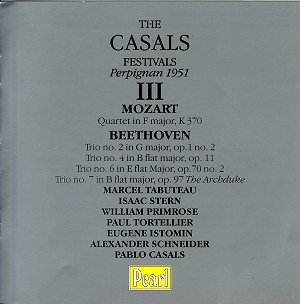The Prades Festival performances given by Casals and
his extensive circle have rather overshadowed the series of concerts
given at the Perpignan Festival in July 1951. It was Alexander – Sasha
– Schneider of the Budapest Quartet who encouraged the initially reluctant
cellist to give a series of Summer Festivals in Prades and Perpignan,
Casals living in exile from Franco’s Spain. By degrees – cajoling, present-giving
and general insinuation – and the arrival of a donated Pleyel Grand
and informal visits from leading musicians the 1950 Bach Festival was
organised and led to the establishment of those celebrated subsequent
Festivals enshrined on disc, of which this is Volume III in Pearl’s
edition.
It’s wonderful, of course, to have these performances
available in a comprehensive and cogent set well transferred from the
early LPs and with notes by Dr Martin Leigh. No one could deny that
Casals’ presence is one of constant illumination but equally he was
seventy-five at the time and well past his best when the fruits of Schneider’s
labours bore fruit.
Mozart’s Oboe Quartet – the only performance sans Casals
– opens this double CD set. A stellar line up of international, predominantly
American-based instrumentalists took part; French oboist Marcel Tabuteau,
American violinist Isaac Stern, British violist William Primrose and
French cellist Paul Tortelier (whose name is consistently misspelled
in Pearl’s documentation). Stern and Primrose collaborated with Casals
in a comatose performance of the Sinfonia Concertante but here, unhampered
by Casals’ ponderousness they conjoin in a likeable and fluid reading
of the Quartet. Stern could be a vindictive colleague and Primrose a
hawk-eyed one but with Tortelier a most sympathetic emollient they give
the gracious and elegant oboist judiciously weighted support and quite
dissimilar, tonally and expressively, from a contemporary such as Goossens.
The bulk of the performances however are given over
to Beethoven. The G Major trio is distended to thirty-eight minutes
in length. Gruff accents predominate, lines are fragmented, phrasing
is only intermittently convincing. In the Largo Istomin takes – or is
encouraged to take (one tends to feel him holding back his natural tempo)
- a rather ponderous approach with the result that he sounds rather
lumpy. The B Flat Major is, in its tough and unvarnished way not unattractive.
Casals’ famous groans are extremely audible here but there is some delightful
and elfin playing from the trio in the Adagio in particular. The Op
70 Trio, E Flat Major, features some dramatic instrumental exchanges.
Istomin’s fluency is a constantly attractive focus here and they certainly
mine the Allegretto for all its worth – with an almost choreographic
dynamism, rocking and striding with Schneider’s sometimes astringent
tone cutting through the buzz of Casals’ cello. The heavy rhythm is
certainly implicit here if a little wanting in subtlety. But admirable
are the softened dynamics in the third movement Allegro ma non troppo
that is full of a sense of almost quizzical stasis, suffused with genuine
intensity. The finale rather lets down the performance. Casals’ intonational
problems here are oppressive and Schneider, never perhaps the most beautiful
of stylists, receives perhaps less than helpful recording balance.
The masterpiece of the Trios is of course the Archduke.
This one clocks in at 43 minutes, a remarkable 10 minutes slower
than the Cortot- Thibaud-Casals 78 traversal of 1928, albeit in 1951
they do play the exposition repeat in the first movement. If you admire,
say, Gilels-Kogan-Rostropovich you will possibly be nonplussed by the
Istomin-Schneider-Casals team. The weighty introduction is lavished
with some initially smeary sentimental phrasing. Casals is again gruff
and Schneider hardly beyond technical reproach. The pizzicato episode
is one of almost overwhelming power and imagination however in a movement,
objectively at least, far too slow. I can’t say it convinced me as an
example of structural integrity but some sacrifices need to be made
for Casals’ intense involvement - though I have to say that the 1928
recording was equally flawed as a performance and, on record at least,
Casals never got the Archduke right. In the Scherzo the trio
navigate the winding patterns that move through it and vest the music
with what I can best call a mock-heroic portentousness. The slow movement
though is very slow – fourteen minutes - and at this tempo relation
of thematic material becomes tangential and forced. Intense concentration
by Casals leads to anticipatory groaning from him but his intonation
takes a corresponding battering. The two string players make very theatrical
attacks and theirs was not an ensemble I especially relish – with Thibaud,
the resultant tonal ambiguities were, miraculously, a force for creative
good – but here it’s far too sketchy and disparate. I’m sure Istomin,
fluent if not exceptionally creative, again holds and reins back his
natural instinct for a quicker tempo as the movement drags forlornly
to its close. The finale is a hobble-toed and reasonably attractive
but the vices that afflict the Trio emerge at the close where the ending
is nowhere near as overwhelming and vital as it should be.
There were a remarkable gathering of performers, recorded
in the courtyard of the Palace of Kings of Majorca – and originally
released on Columbia ML 4554, 4559, 4561 and 4562. The outdoor recording
location meant quality was rather less than optimum and ensemble less
than perfect. And though I have been hard on the performances this is
only a subjective reaction; much here is noble, lofty, cherishable and
of lasting artistic validity.
Jonathan Woolf


